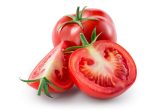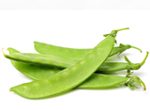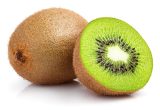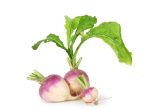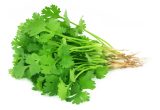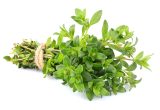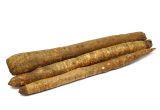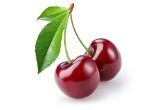Chard

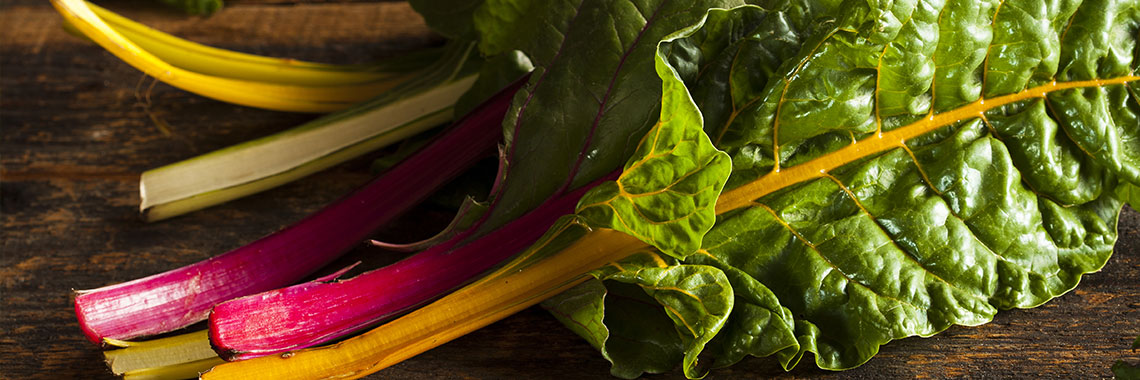
Description
- Chard (Beta vulgaris), also called Swiss chard, belongs to the Chenopodiaceae family.
- This plant has adapted its growth cycle to seasonal temperatures and variations in photo-exposure in temperate regions (Leiva-Eriksson, 2014).
- Chard is an important crop of temperate climates (Dohm, 2014).
PHYSICAL AND ORGANOLEPTIC CHARACTERISTICS
- The leaves of the ornamental chard variety (Beta vulgaris Cicla) are characterised by intense colour, with large ribbed blades and broad grooved stems arranged in a rosette (Zawadzińska, 2017).
- Depending on the cultivar, Swiss chard can reach 60 cm in height (Zawadzińska, 2017).
- The plant has a moderately deep root system (Rana, 2017).
- The presence of certain pigments such as betalains are responsible for the colouring of the chard. In fact, betacyanins provide the red-purple colour, while betaxanthins give the yellow colour to chard (Jain, 2012).
- The pigments present in chard are chlorophyll, lycopene and β-carotene (Mzoughi, 2019).
- Non-terpene derivatives and sesquiterpene hydrocarbons are believed to be the essential volatile compounds in chard leaves (Mzoughi, 2019).
COMPOSITION CHARACTERISTICS (excluding macronutrients, vitamins and minerals)
- The amounts of the chlorophylls and carotenoids pigments may be improved through various cultivation practices such as temperature, light and mineral levels (Barickman, 2016).
- The following five C-glycoside flavones: Apigenin 8-C-β-D-glucopyranoside (vitexin) (1), Oxylopyranosylvitexin (2), acetin 8-C-β-D-glucopyranoside (3), acetin 8-C-α-L-rhamnoside (4), and 6,8-di-C-β-D-glucopyranosylapigenin (vecinin-II) (5) were isolated from flavescens variety. Compound 1 showed promising antibacterial activity and compounds 1 and 3 showed superior antidiabetic activities compared to the reference drug acarbose (Mohammed, 2019).
- In addition, wild chard leaf extract revealed significant antioxidant capacity as well as hypoglycemic activity due to its inhibitory effect on α-glucosidase and α-amylase enzymes. The authors attributed the inhibitory effects of these enzymes to saponins, which are capable of inhibiting gluconeogenesis and glycogenolysis (Mzoughi, 2019).
*Average composition given as an indication: the following values are approximate and depend on variety, season, ripeness, cultivation conditions, etc. The data on polyphenols is taken from the Phenol-Explorer 3.0 database. All other data is taken from the Ciqual Table of nutritional composition of foods (2017) – ANSES, except for the Vitamin A equivalent which corresponds to the division of the Beta-carotene content by 6.
RAW
The following values are approximate and depend on variety, season, ripeness, cultivation conditions, etc.
Raw chard is low in energy* as it provides an average of 16.40 calories (kcal) per 100 g, i.e. 68.30 kJ.
It is one of the lowest calorie vegetables according to the Ciqual 2020 table.
COMPOSITION TABLES
For each nutrient, the tables provide information on the content, the minimum and maximum values, as well as the percentage of the Dietary Reference Values (DRVs) for 100 g net of raw chard.
Regulation (EC) No 1924/2006 of the European Parliament and of the Council of 20 December 2006 on nutrition and health claims made on foods.
MACRONUTRIENTS
| Constituent (g) | Average content |
Min-Max per 100g |
DRV% |
|---|---|---|---|
| Water | 95,4 | 92,70 - NC | - |
| Fibers | 1,80 | 1,60 - NC | - |
| Carbohydrates | 1,63 | 0,50 - 3 | 0,63 |
| Sugars | 1,20 | 1,10 - NC | 1,33 |
| Lipids | < 0,50 | 0,20 - NC | - |
| Saturated fat | < 0,01 | NC - 0,03 | - |
| Protein | 1 | NC - 2,10 | 2 |
| Constituent (g) | Amount | Min-Max | DRV% |
|---|---|---|---|
| Water | Ciqual 2020 | - | Règlement (UE) N°1169/2011 du parlement Européen et du conseil du 25 octobre 2011 |
| Fibers | Ciqual 2020 | - | - |
| Carbohydrates | Ciqual 2020 | - | Règlement (UE) N°1169/2011 du parlement Européen et du conseil du 25 octobre 2011 |
| Sugars | Ciqual 2020 | - | Règlement (UE) N°1169/2011 du parlement Européen et du conseil du 25 octobre 2011 |
| Lipids | Ciqual 2020 | - | Règlement (UE) N°1169/2011 du parlement Européen et du conseil du 25 octobre 2011 |
| Saturated fat | Ciqual 2020 | - | Règlement (UE) N°1169/2011 du parlement Européen et du conseil du 25 octobre 2011 |
| Protein | Ciqual 2020 | - | Règlement (UE) N°1169/2011 du parlement Européen et du conseil du 25 octobre 2011 |
Zoom on carbohydrates
- The amount of carbohydrates (1.63 g per 100 g) in raw chard is much lower than the average amount found in raw vegetables (4.45 g per 100 g).
- Raw chard is low in sugar* as it contains less than 5 g per 100 g, i.e. 1.20 g per 100 g.
Zoom on fibres
- The fibre content (1.80 g per 100 g) of raw chard is lower than the average amount found in raw vegetables (2.43 g per 100 g).
Zoom on proteins
- The amount of protein (1 g per 100 g) in raw chard is lower than the average amount found in raw vegetables (1.87 g per 100 g).
Zoom on lipids
- Raw chard is fat-free*, as it contains less than 0.5 g of fat per 100 g.
*Regulation (EC) No 1924/2006 of the European Parliament and of the Council of 20 December 2006 on nutrition and health claims made on foods.
MINERALS AND TRACE ELEMENTS
| Constituent | Average content |
Min-Max per 100g |
DRV% |
|---|---|---|---|
| Calcium (mg) | 25 | NC - 51 | 3,13 |
| Chloride (mg) | - | - | - |
| Copper (mg) | 0,03 | NC - 0,18 | 3 |
| Iron (mg) | 0,85 | NC - 1,80 | 6,07 |
| Iodine (µg) | < 20 | - | - |
| Magnesium (mg) | 17 | NC - 81 | 4,53 |
| Manganese (mg) | 0,16 | NC - 0,37 | 8 |
| Phosphorus (mg) | 10 | NC - 46 | 1,43 |
| Potassium (mg) | 300 | NC - 379 | 15 |
| Selenium (µg) | < 20 | - | - |
| Sodium (mg) | 53,20 | 17,10 - 93,20 | - |
| Zinc (mg) | 0,07 | NC - 0,36 | 0,70 |
| Constituent | Amount | Min-Max | DRV% |
|---|---|---|---|
| Calcium (mg) | Ciqual 2020 | - | Règlement (UE) N°1169/2011 du parlement Européen et du conseil du 25 octobre 2011 |
| Chloride (mg) | Ciqual 2020 | - | Règlement (UE) N°1169/2011 du parlement Européen et du conseil du 25 octobre 2011 |
| Copper (mg) | Ciqual 2020 | - | Règlement (UE) N°1169/2011 du parlement Européen et du conseil du 25 octobre 2011 |
| Iron (mg) | Ciqual 2020 | - | Règlement (UE) N°1169/2011 du parlement Européen et du conseil du 25 octobre 2011 |
| Iodine (µg) | Ciqual 2020 | - | Règlement (UE) N°1169/2011 du parlement Européen et du conseil du 25 octobre 2011 |
| Magnesium (mg) | Ciqual 2020 | - | Règlement (UE) N°1169/2011 du parlement Européen et du conseil du 25 octobre 2011 |
| Manganese (mg) | Ciqual 2020 | - | Règlement (UE) N°1169/2011 du parlement Européen et du conseil du 25 octobre 2011 |
| Phosphorus (mg) | Ciqual 2020 | - | Règlement (UE) N°1169/2011 du parlement Européen et du conseil du 25 octobre 2011 |
| Potassium (mg) | Ciqual 2020 | - | Règlement (UE) N°1169/2011 du parlement Européen et du conseil du 25 octobre 2011 |
| Selenium (µg) | Ciqual 2020 | - | Règlement (UE) N°1169/2011 du parlement Européen et du conseil du 25 octobre 2011 |
| Sodium (mg) | Ciqual 2020 | - | Règlement (UE) N°1169/2011 du parlement Européen et du conseil du 25 octobre 2011 |
| Zinc (mg) | Ciqual 2020 | - | Règlement (UE) N°1169/2011 du parlement Européen et du conseil du 25 octobre 2011 |
Zoom on minerals and trace elements
- Raw chard is a source of:
- chloride as it provides the equivalent of 27.63% of DRVs, i.e. 221 mg per 100 g; moreover, according to the Ciqual 2020 composition table, raw Swiss chard is, after cooked peas, the vegetable that contains the most chloride.
- potassium as it provides the equivalent of 15% of DRVs, i.e. 300 mg per 100 g.
- The other minerals and trace elements are present in quantities representing less than 8% of DRVs.
VITAMINS
| Constituent | Average content |
Min-Max per 100g |
DRV% |
|---|---|---|---|
| Provitamin A Beta-carotene (µg) | 25,90 | NC - 4570 | - |
| Vitamin A equivalent (µg) | 4,32 | NC - 762 | 0,54 |
| Vitamin B1 (mg) | < 0,015 | NC - 0,04 | - |
| Vitamin B2 (mg) | 0,015 | NC - 0,09 | 1,07 |
| Vitamin B3 (mg) | < 0,10 | NC - 0,40 | - |
| Vitamin B5 (mg) | 0,20 | 0,17 - NC | 3,33 |
| Vitamin B6 (mg) | 0,036 | NC - 0,099 | 2,57 |
| Vitamin B9 (µg) | 24,70 | 14 - NC | 12,35 |
| Vitamin C (mg) | 3,08 | NC - 30 | 3,85 |
| Vitamin E (mg) | 0,25 | NC - 1,89 | 2,08 |
| Vitamin K1 (µg) | < 0,80 | NC - 830 | - |
| Constituent | Amount | Min-Max | DRV% |
|---|---|---|---|
| Provitamin A Beta-carotene (µg) | Ciqual 2020 | - | - |
| Vitamin A equivalent (µg) | Calcul à partir de la valeur Provitamine A Béta-carotène* | - | Règlement (UE) N°1169/2011 du parlement Européen et du conseil du 25 octobre 2011 |
| Vitamin B1 (mg) | Ciqual 2020 | - | Règlement (UE) N°1169/2011 du parlement Européen et du conseil du 25 octobre 2011 |
| Vitamin B2 (mg) | Ciqual 2020 | - | Règlement (UE) N°1169/2011 du parlement Européen et du conseil du 25 octobre 2011 |
| Vitamin B3 (mg) | Ciqual 2020 | - | Règlement (UE) N°1169/2011 du parlement Européen et du conseil du 25 octobre 2011 |
| Vitamin B5 (mg) | Ciqual 2020 | - | Règlement (UE) N°1169/2011 du parlement Européen et du conseil du 25 octobre 2011 |
| Vitamin B6 (mg) | Ciqual 2020 | - | Règlement (UE) N°1169/2011 du parlement Européen et du conseil du 25 octobre 2011 |
| Vitamin B9 (µg) | Ciqual 2020 | - | Règlement (UE) N°1169/2011 du parlement Européen et du conseil du 25 octobre 2011 |
| Vitamin C (mg) | Ciqual 2020 | - | Règlement (UE) N°1169/2011 du parlement Européen et du conseil du 25 octobre 2011 |
| Vitamin E (mg) | Ciqual 2020 | - | Règlement (UE) N°1169/2011 du parlement Européen et du conseil du 25 octobre 2011 |
| Vitamin K1 (µg) | Ciqual 2020 | - | Règlement (UE) N°1169/2011 du parlement Européen et du conseil du 25 octobre 2011 |
Zoom on vitamins
- Raw chard contains a significant amount of vitamin B9, as it represents 12.35% of DRVs, i.e. 24.70 µg per 100 g.
- The other vitamins are present in quantities representing less than 4% of DRVs.
*Calculation made: Beta-Carotene / 6 + retinol
POLYPHENOLS
| Constituent (mg) | Average content |
Min-Max per 100mg |
|---|---|---|
| Flavonoids (mg) | 11,10 | 11,10 - 11,10 |
| of which Flavonols (mg) | 11,10 | 11,10 - 11,10 |
| Phenolic Acids (mg) | 88,9 | 88,90 - 88,90 |
| of which Hydroxybenzoic acids (mg) | 58,40 | 58,40 - 58,40 |
| of which Hydroxycinnamic acids (mg) | 30,50 | 30,50 - 30,50 |
| Lignanes (mg) | 0,008 | 0,008 - 0,008 |
| Total polyphenols | 100 | 100 - 100 |
| Constituent (mg) | Amount | Min-Max |
|---|---|---|
| Flavonoids | Phénol-Explorer version 3.6 Méthode utilisée : Chromatographie après hydrolyse | - |
| of which Flavonols | Phénol-Explorer version 3.6 Méthode utilisée : Chromatographie après hydrolyse | - |
| Phenolic Acids | Phénol-Explorer version 3.6 Méthode utilisée : Chromatographie après hydrolyse | - |
| of which Hydroxybenzoic acids | Phénol-Explorer version 3.6 Méthode utilisée : Chromatographie après hydrolyse | - |
| of which Hydroxycinnamic acids | Phénol-Explorer version 3.6 Méthode utilisée : Chromatographie après hydrolyse | - |
| Lignanes | Phénol-Explorer version 3.6 Méthode utilisée : Chromatographie après hydrolyse | - |
| Total polyphenols | Phénol-Explorer version 3.6 Méthode utilisée : Chromatographie après hydrolyse | - |
Zoom on polyphenols (raw white chard)
- Polyphenols are substances with an antioxidant effect.
- Chard contains a significant amount of polyphenols, as determined by chromatographic analysis after hydrolysis.
- Phenolic acids are predominantly present in raw chard composites, representing 89% of the total polyphenols identified. They are mainly in the form of hydroxybenzoic acids.
COOKED
The following values are approximate and depend on variety, season, ripeness, cultivation conditions, etc.
Cooked chard is low in energy* as it provides an average of 16.90 calories (kcal) per 100 g, i.e. 70 kJ.
It is one of the lowest calorie vegetables according to the Ciqual 2020 table.
COMPOSITION TABLES
For each nutrient, the tables provide information on the content, minimum and maximum values, as well as the percentage of the Dietary Nutrient Values (DRVs) for 100 g net of chard, stalks and leaves, boiled/cooked in water.
Regulation (EC) No 1924/2006 of the European Parliament and of the Council of 20 December 2006 on nutrition and health claims made on foods.
MACRONUTRIENTS
Constituent
(g)
Average content
Min-Max
per 100g
DRV%
Water
95,20
-
-
Fibers
2,50
-
-
Carbohydrates
1,43
0 - NC
0,55
Sugars
1
-
1,11
Lipids
0,30
-
0,43
Saturated fat
0,10
-
0,50
Protein
0,88
NC - 0,90
1,76
Constituent
(g)
Amount
Min-Max
DRV%
Water
Ciqual 2020 (valeur issue des analyses Ciqual-Aprifel 2018)
-
-
Fibers
Ciqual 2020 (valeur issue des analyses Ciqual-Aprifel 2018)
-
-
Carbohydrates
Ciqual 2020
-
Règlement (UE) N°1169/2011 du parlement Européen et du conseil du 25 octobre 2011
Sugars
Ciqual 2020 (valeur issue des analyses Ciqual-Aprifel 2018)
-
Règlement (UE) N°1169/2011 du parlement Européen et du conseil du 25 octobre 2011
Lipids
Ciqual 2020 (valeur issue des analyses Ciqual-Aprifel 2018)
-
Règlement (UE) N°1169/2011 du parlement Européen et du conseil du 25 octobre 2011
Saturated fat
Ciqual 2020 (valeur issue des analyses Ciqual-Aprifel 2018)
-
Règlement (UE) N°1169/2011 du parlement Européen et du conseil du 25 octobre 2011
Protein
Ciqual 2020 (valeur issue des analyses Ciqual-Aprifel 2018)
-
Règlement (UE) N°1169/2011 du parlement Européen et du conseil du 25 octobre 2011
Zoom on carbohydrates
- The amount of carbohydrates (1.43 g per 100 g) in boiled chard is much lower than the average amount found in cooked vegetables (4.85 g per 100 g).
- Its carbohydrates are mainly glucose (0.70 g per 100 g) and fructose (0.30 g per 100 g).
- Boiled chard is low in sugar* as it contains less than 5 g of sugar per 100 g.
Zoom on fibres
- The fibre content (2.50 g per 100 g) of boiled chard is lower than the average value for cooked vegetables (2.89 g per 100 g).
Zoom on proteins
- The amount of protein (0.88 g per 100 g) in cooked chard is lower than the average amount found in cooked vegetables (2 g per 100 g).
Zoom on lipids
- The amount of fat (0.30 g per 100 g) in cooked chard is lower than the average amount found in cooked vegetables (0.53 g per 100 g).
- Moreover, the claim “fat-free*” can be used for boiled chard because it contains less than 0.5 g of fat per 100 g.
*Regulation (EC) No 1924/2006 of the European Parliament and of the Council of 20 December 2006 on nutrition and health claims made on foods.
MINERALS AND TRACE ELEMENTS
| Constituent | Average content |
Min-Max per 100g |
DRV% |
|---|---|---|---|
| Calcium (mg) | 60 | - | 7,50 |
| Chloride (mg) | 79,6 | - | 9,95 |
| Copper (mg) | 0,04 | - | 4 |
| Iron (mg) | 0,52 | - | 3,71 |
| Iodine (µg) | < 20 | - | - |
| Magnesium (mg) | 10 | - | 2,67 |
| Manganese (mg) | 0,34 | - | 17 |
| Phosphorus (mg) | 18 | - | 2,57 |
| Potassium (mg) | 160 | - | 8 |
| Selenium (µg) | < 20 | - | - |
| Sodium (mg) | 77 | - | - |
| Zinc (mg) | 0,11 | - | 1,10 |
| Constituent | Amount | Min-Max | DRV% |
|---|---|---|---|
| Calcium (mg) | Ciqual 2020 (valeur issue des analyses Ciqual-Aprifel 2018) | - | Règlement (UE) N°1169/2011 du parlement Européen et du conseil du 25 octobre 2011 |
| Chloride (mg) | Ciqual 2020 (valeur issue des analyses Ciqual-Aprifel 2018) | - | Règlement (UE) N°1169/2011 du parlement Européen et du conseil du 25 octobre 2011 |
| Copper (mg) | Ciqual 2020 (valeur issue des analyses Ciqual-Aprifel 2018) | - | Règlement (UE) N°1169/2011 du parlement Européen et du conseil du 25 octobre 2011 |
| Iron (mg) | Ciqual 2020 (valeur issue des analyses Ciqual-Aprifel 2018) | - | Règlement (UE) N°1169/2011 du parlement Européen et du conseil du 25 octobre 2011 |
| Iodine (µg) | Ciqual 2020 (valeur issue des analyses Ciqual-Aprifel 2018) | - | Règlement (UE) N°1169/2011 du parlement Européen et du conseil du 25 octobre 2011 |
| Magnesium (mg) | Ciqual 2020 (valeur issue des analyses Ciqual-Aprifel 2018) | - | Règlement (UE) N°1169/2011 du parlement Européen et du conseil du 25 octobre 2011 |
| Manganese (mg) | Ciqual 2020 (valeur issue des analyses Ciqual-Aprifel 2018) | - | Règlement (UE) N°1169/2011 du parlement Européen et du conseil du 25 octobre 2011 |
| Phosphorus (mg) | Ciqual 2020 (valeur issue des analyses Ciqual-Aprifel 2018) | - | Règlement (UE) N°1169/2011 du parlement Européen et du conseil du 25 octobre 2011 |
| Potassium (mg) | Ciqual 2020 (valeur issue des analyses Ciqual-Aprifel 2018) | - | Règlement (UE) N°1169/2011 du parlement Européen et du conseil du 25 octobre 2011 |
| Selenium (µg) | Ciqual 2020 (valeur issue des analyses Ciqual-Aprifel 2018) | - | Règlement (UE) N°1169/2011 du parlement Européen et du conseil du 25 octobre 2011 |
| Sodium (mg) | Ciqual 2020 (valeur issue des analyses Ciqual-Aprifel 2018) | - | - |
| Zinc (mg) | Ciqual 2020 (valeur issue des analyses Ciqual-Aprifel 2018) | - | Règlement (UE) N°1169/2011 du parlement Européen et du conseil du 25 octobre 2011 |
Zoom on minerals and trace elements
- Boiled chard is a source of manganese as it provides the equivalent of 17% of DRVs, i.e. 0.34 mg per 100 g.
- It contains a significant amount of chloride. It represents 9.94% of DRVs, i.e. 79.60mg per 100g.
- The other minerals and trace elements are present in quantities representing less than 8% of DRVs.
VITAMINS
| Constituent | Average content |
Min-Max per 100g |
DRV% |
|---|---|---|---|
| Provitamin A Beta-carotene (µg) | 1 260 | - | - |
| Vitamin A equivalent (µg) | 210 | - | 26,25 |
| Vitamin B1 (mg) | < 0,015 | - | - |
| Vitamin B2 (mg) | < 0,01 | - | - |
| Vitamin B3 (mg) | < 0,10 | - | - |
| Vitamin B5 (mg) | 0,10 | - | 1,67 |
| Vitamin B6 (mg) | 0,098 | - | 7 |
| Vitamin B9 (µg) | 18,30 | - | 9,15 |
| Vitamin C (mg) | < 0,50 | - | - |
| Vitamin E (mg) | < 0,08 | - | - |
| Vitamin K1 (µg) | 8,29 | - | 11,05 |
| Constituent | Amount | Min-Max | DRV% |
|---|---|---|---|
| Provitamin A Beta-carotene (µg) | Ciqual 2020 (valeur issue des analyses Ciqual-Aprifel 2018) | - | - |
| Vitamin A equivalent (µg) | Calcul à partir de la valeur Provitamine A Béta-carotène* | - | Règlement (UE) N°1169/2011 du parlement Européen et du conseil du 25 octobre 2011 |
| Vitamin B1 (mg) | Ciqual 2020 (valeur issue des analyses Ciqual-Aprifel 2018) | - | Règlement (UE) N°1169/2011 du parlement Européen et du conseil du 25 octobre 2011 |
| Vitamin B2 (mg) | Ciqual 2020 (valeur issue des analyses Ciqual-Aprifel 2018) | - | Règlement (UE) N°1169/2011 du parlement Européen et du conseil du 25 octobre 2011 |
| Vitamin B3 (mg) | Ciqual 2020 (valeur issue des analyses Ciqual-Aprifel 2018) | - | Règlement (UE) N°1169/2011 du parlement Européen et du conseil du 25 octobre 2011 |
| Vitamin B5 (mg) | Ciqual 2020 (valeur issue des analyses Ciqual-Aprifel 2018) | - | Règlement (UE) N°1169/2011 du parlement Européen et du conseil du 25 octobre 2011 |
| Vitamin B6 (mg) | Ciqual 2020 (valeur issue des analyses Ciqual-Aprifel 2018) | - | Règlement (UE) N°1169/2011 du parlement Européen et du conseil du 25 octobre 2011 |
| Vitamin B9 (µg) | Ciqual 2020 (valeur issue des analyses Ciqual-Aprifel 2018) | - | Règlement (UE) N°1169/2011 du parlement Européen et du conseil du 25 octobre 2011 |
| Vitamin C (mg) | Ciqual 2020 (valeur issue des analyses Ciqual-Aprifel 2018) | - | Règlement (UE) N°1169/2011 du parlement Européen et du conseil du 25 octobre 2011 |
| Vitamin E (mg) | Ciqual 2020 | - | Règlement (UE) N°1169/2011 du parlement Européen et du conseil du 25 octobre 2011 |
| Vitamin K1 (µg) | Ciqual 2020 (valeur issue des analyses Ciqual-Aprifel 2018) | - | Règlement (UE) N°1169/2011 du parlement Européen et du conseil du 25 octobre 2011 |
Zoom on vitamins
- Beta-carotene is a precursor of vitamin A (provitamin A), a family of carotenoids. It has the capacity to be transformed into vitamin A in the body.
- Boiled chard is a source of vitamin A, as it provides the equivalent of 26.25% of DRVs, i.e. 210 µg per 100 g.
- The 2nd most represented vitamin in cooked chard is vitamin K1 with a content equivalent to 11.05% of DRVs. It is followed by vitamin B9 with a content equivalent to 9.15% of DRVs.
- The other vitamins are present in quantities representing less than 8% of DRVs.
*Calculation made: Beta-Carotene / 6 + retinol
POLYPHENOLS
Nutrition and health claims
According to the definitions of nutrition claims as set out in Regulation (EC) No 1924/2006 on nutrition and health claims, and in view of the composition of raw chard, the following claims may be used:
NUTRITION CLAIMS OF RAW CHARD
- Low in energy (100 g of raw chard provide less than 40 kcal)
- Low in sugar (100 g of raw chard contain less than 5 g)
- Fat-free (100 g of raw chard contain less than 0.5 g)
- Source of chloride (100 g of raw chard provide the equivalent of more than 15% of DRVs)
- Source of potassium (100 g of raw chard provide the equivalent of more than 15% of DRVs)
HEALTH CLAIMS (for a consumption of 100 g of raw chard)
Chloride
- Chloride contributes to normal digestion by production of hydrochloric acid in the stomach.
Potassium
- Potassium contributes to:
- normal functioning of the nervous system,
- normal muscle function,
- maintenance of normal blood pressure.
Nutrition and health claims
According to the definitions of nutrition claims as presented in Regulation (EC) No 1924/2006 on nutrition and health claims, and in view of the composition of boiled chard, the following claims may be used:
NUTRITION CLAIMS OF BOILED CHARD
- Low in energy (100 g of boiled chard provide less than 40 kcal)
- Low in sugar (100 g of boiled chard contain less than 5 g)
- Fat-free (100g of boiled chard provide less than 0.5 g)
- Source of vitamin A (100 g of boiled chard provide the equivalent of more than 15% of DRVs)
- Source of manganese (100 g of boiled chard provide the equivalent of more than 15% of DRVs)
HEALTH CLAIMS (for a consumption of 100 g of cooked chard)
Vitamin A
- Vitamin A has a role in the process of cell specialisation.
- Vitamin A contributes to:
- maintenance of normal skin,
- maintenance of normal mucous membranes,
- maintenance of normal vision,
- normal iron metabolism,
- normal function of the immune system.
Manganese
- Manganese contributes to:
- normal energy-yielding metabolism,
- maintenance of normal bones,
- normal formation of connective tissues,
- protection of cells from oxidative stress.
References
- Agence nationale de sécurité sanitaire de l’alimentation, de l’environnement et du travail. Table de composition nutritionnelle des aliments Ciqual 2020. Consultée le 06/08/2020 depuis le site internet Ciqual https://ciqual.anses.fr/
- Barickman TC, Kopsell DA. Nitrogen form and ratio impact Swiss chard (Beta vulgaris subsp. cicla) shoot tissue carotenoid and chlorophyll concentrations. Scientia Horticulturae. 2016;204(1):99-105.
- Dohm JC, Minoche AE, Holtgräwe D, Capella-Gutiérrez S, Zakrzewski F, Tafer H, Rupp O, Sörensen TR, Stracke R, Reinhardt R, Goesmann A, Kraft T, Schulz B, Stadler PF, Schmidt T, Gabaldón T, Lehrach H, Weisshaar B, Himmelbauer H. The genome of the recently domesticated crop plant sugar beet (Beta vulgaris). Nature. 2014;505(7484):546-9.
- Jain NK, Singhai AK. Protective role of Beta vulgaris L. leaves extract and fractions on ethanol-mediated hepatic toxicity. Acta Pol Pharm. 2012;69(5):945-50.
- Leiva-Eriksson N, Pin PA, Kraft T, Dohm JC, Minoche AE, Himmelbauer H, Bülow L. Differential expression patterns of non-symbiotic hemoglobins in sugar beet (Beta vulgaris ssp. vulgaris). Plant Cell Physiol. 2014;55(4):834-44.
- Mohammed HS, Abdel-Aziz MM, Abu-Baker MS, Saad AM, Mohamed MA, Ghareeb MA. Antibacterial and Potential Antidiabetic Activities of Flavone C-glycosides Isolated from Beta vulgaris Subspecies cicla L. var. Flavescens (Amaranthaceae) Cultivated in Egypt. Curr Pharm Biotechnol. 2019;20(7):595-604.
- Mzoughi A, Chahdoura H, Chakroun Y, Cámara M, Fernández-Ruiz V, Morales P, Mosbah H, Flamini G, Snoussi M, Majdoub H. Wild edible Swiss chard leaves (Beta vulgaris L. var. cicla): Nutritional, phytochemical composition and biological activities. Food Research International. 2019;119(1):612-621.
- Neveu V, Perez-Jiménez J, Vos F, Crespy V, du Chaffaut L, Mennen L, Knox C, Eisner R, Cruz J, Wishart D, Scalbert A. (2010) Phenol-Explorer: an online comprehensive database on polyphenol contents in foods. Database, doi: 10.1093/database/bap024. Full text (free access)
- Rana, M.K. (Ed.). (2017). Vegetable Crop Science (1st ed.). CRC Press. .
- Règlement (CE) N° 1924/2006 du Parlement européen et du Conseil du 20 décembre 2006 concernant les allégations nutritionnelles et de santé portant sur les denrées alimentaires.
- Règlement (UE) N°432/2012 de la Commission du 16 mai 2012 établissant une liste des allégations de santé autorisées portant sur les denrées alimentaires, autres que celles faisant référence à la réduction du risque de maladie ainsi qu’au développement et à la santé infantiles.
- Règlement (UE) n°1169/2011 du Parlement européen et du Conseil du 25 octobre 2011 concernant l’information des consommateurs sur les denrées alimentaires, modifiant les règlements (CE) n°1924/2006 et (CE) n°1925/2006 du Parlement européen et de Conseil et abrogeant la directive 87/250/CEE de la Commission, la directive 90/496/CEE du Conseil, la directive 1999/10/CE de la Commission, la directive 200/13/CE du Parlement européen et du Conseil, les directives 2002/67/CE et 2008/5/CE de la Commission et le règlement (CE) n°608/2004 de la Commission.
- Zawadzińska A, Salachna P, Piechocki R. Ornamental swiss chard (Beta vulgaris var. cicla) response to daminozide and flurprimidol. World Scientific News. 2017;61(2):86-97.




